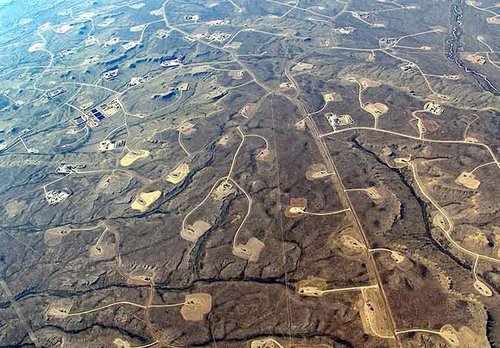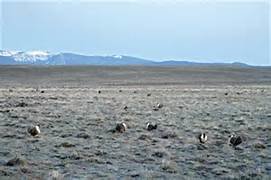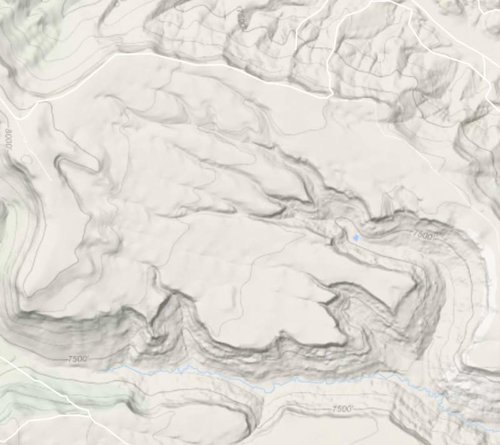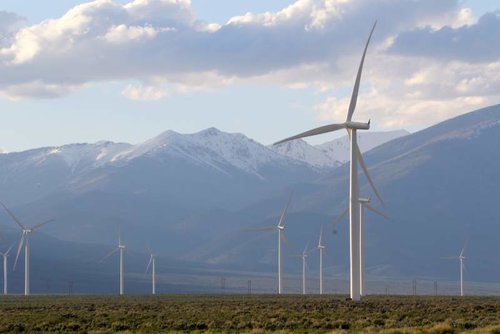The Guardian had another good article in its series “This Land is Your Land” They go in depth on the fight to save the Sage Grouse.
Towards the end, you will read about Interior Secretary Ryan Zinke’s (The extraction industries nominee for man of the year 2017) push to reduce protections for the bird. I have bolded this section if you wish to go to it directly.
Here is the article less a few sentences:
A plan to save the sage grouse was a rare instance where ranchers, the timber industry, scientists, landowners and environmentalists all agreed on something.
The male sage grouse is surprisingly beautiful, and famous for a chest-shaking mating dance. Photograph: Handout/ReutersAt 5am, the day is black, and resounds with the steady drum of rain. My husband Rich is getting ready for work. He oils his leather gloves and fills a Thermos. He’ll spend a 10-hour day in the downpour: tramping through thorny salmonberry and wading through the roaring creeks.
We live in the Oregon Coast Range, a region that’s been in steady economic decline since the sawmills began shutting down in the late 1980s. Before Rich got this job we were living hand to mouth. Now things are looking up. It won’t make us wealthy, but Rich has scored one of the best jobs in our remote neck of the woods.
In the past two decades, rural people across the west have formed successful coalitions to rehabilitate ecosystems while simultaneously providing jobs to stimulate destitute economies. As divisive rhetoric dominates the American story, backwater communities have been making small but vital steps to bridge the red/blue divide.
“We must have both productivity and protection on the same landscape,” says Johnny Sundstrom, a guiding force in community-based conservation and the track coach at our local high school. Sundstrom is quick to point out that salmon habitat is merely a starting point. “Recovery plans should deal with all species – including humans,” he says. He acknowledges that the restoration economy will never take the place of five mills running two shifts, but notes that his organization spent $330,000 on a single project last year.
Farther east, Wallowa County (population 7,000) is a remarkable economic success story. This notoriously red county came out swinging for Donald Trump (67.2%), yet it boasts one of the most progressive community development plans in rural America. This is due, in part, to Wallowa Resources, a local group that formed in the wake of the mill closures of the 1990s. The grassroots organization supported the launch of nine new businesses, with a focus on renewable energy and sustainable logging.
Projects include watershed restoration, small-scale hydropower, partnering with ranchers to control noxious weeds, and turning the byproducts of forest restoration into poles and firewood.
Wallowa County’s focus on economic development is impressive, but collaborative restoration is more typically centered on saving a specific species.
Take, for instance, the western sage grouse. With his snowy ruff, golden crests, and spiky tail feathers, the male sage grouse is surprisingly beautiful, and famous for a chest-shaking mating dance. But lately the bird’s population count has drawn more attention than its dance moves – partially because the dwindling numbers indicate the ailing health of the sage-steppe – one of North America’s most imperiled ecosystems.
The sage grouse ranges over 11 western states, which made it daunting to attempt a comprehensive strategy for habitat rehabilitation. The 2015 Sage Grouse Conservation Plan is the largest inclusive conservation effort in US history – the result of five years of negotiation between ranchers, state governments, conservation groups, tribal leaders, hunters, scientists and oil executives.
The goal? Protect habitat without disrupting rural economies.
Since I began studying the restoration economy, I’ve frequently heard the phrase win-win. Collaborative restoration is built on everyone feeling like they’re winning something. It’s the only way to get ranchers, the timber industry, scientists, rural landowners and environmentalists to sit down at the same table.
New threats to public lands endanger America's unique wildlife corridors
The process isn’t pretty – it involves boring meetings and lots of acronyms. Important issues can get shunted to the wayside in favor of innocuous goals that are acceptable to every stakeholder. The process is about thinking far ahead and working together across the aisle – which makes it a strong antidote to the current political atmosphere, and may explain why the Trump administration seems hell-bent on dismantling the work of these bi-partisan rural coalitions.
Why are ranchers and oil interests willing to cooperate with conservationists?
To get to the root of the matter, we’ll need to take a trip back in time. As it so happens, the story takes place in my own hometown.
Jobs weren’t always scarce in the Oregon Coast Range. When white settlers arrived in 1876, they marveled at a land of tall dark forests and rushing streams, a land rich with salmon and timber. They built mills and canneries along the banks of the Siuslaw River. They prospered and were proud of their culture of hardy fishermen and foresters: men who could brave the rain-swept waters and fell trees as tall as skyscrapers.
So what happened? It depends on whom you talk to. Conservationists will tell you something pretty complex: that the decline in salmon populations and subsequent shut-down of the canneries was the result of over-fishing, but also of farming and logging that changed the course of streams, eroding the banks and diminishing the pools that create salmon habitat.
They’ll tell you that logging lead to the near extinction of several other species, notably the northern spotted owl, which in 1990 was listed as a threatened species under The Endangered Species Act (ESA).
But if you sidle up to the bar at Frank’s Place in Mapleton, Oregon, you’ll likely hear a different story.
It’s simpler, but no less affecting. You might hear about the good old days when a family could prosper on one parent’s income at the mills, when the town was a lively and proud place. You’ll be reminded that trees are a renewable resource.
This propensity to blame the owl ignores three key points: mill jobs were already in decline due to increased mechanization and globalization – the practice of shipping whole logs to Asia. And the logging industry couldn’t have continued forever at the same breakneck pace. Trees grow back, but not quickly. Damaged ecosystems don’t produce the same caliber of product.
But there’s no denying that the spotted owl listing caused the passage of the 1994 Northwest Forest Plan, which dramatically reduced logging on federal land.
Mapleton became the kind of town that kids dream of leaving. I was one such kid, growing up during the so-called Timber Wars, when the animosity between environmentalists and foresters was palpable, sometimes violent. Radical environmentalists were spiking trees and half the trucks in town seemed to have the same bumper sticker: Earth First! We’ll log the other planets later.
At that time, I would never have imagined loggers and environmentalists working together. So how did we get from screaming to cooperation?
When it became clear that Coho salmon populations were at a historic low, people on both sides of the environmental debate took the problem seriously. Private landowners and timber interests were willing to sit down at the table with conservationists, community organizations and the state government to hash out a groundbreaking restoration plan.
Ultimately, The Oregon Plan for Salmon and Watersheds was too late – the fish was listed as threatened in 1997. But the state now has a functional and successful habitat restoration program and the inclusive process of building it set a precedent for further cooperation.
Many loggers aren’t environmentalists, but that doesn’t mean they don’t care about the land
The cooperative spirit was alive and well in 2010, when the US Fish and Wildlife Service (USFW) announced that the greater sage grouse warranted protection under the ESA. Estimating that a listing would limit development on millions of acres of land, ranchers and energy interests scrambled to come up with some alternative.
After five years of working with conservationists and government agencies, they created an inclusive protection plan that accounted for the economic and cultural needs of rural people. The effort impressed the USFW, who agreed to hold off on listing the sage grouse – for at least five years.
But the real victory may be for the health of rangelands. The Sage Grouse Initiative is working with ranchers to protect wetlands, manage grazing land with science-based models, and eradicate invading cheatgrass and juniper, which take over sage steppes, eliminating bird habitat and increasing the risk of wild fires. The plan ultimately preserves habitat for 350 species of wildlife.
Many loggers and ranchers won’t call themselves environmentalists, but that doesn’t mean they don’t care about the land. No one knows the woods like a forester; no one knows the rangelands like a rancher. Many rural landowners were doing what they could to keep their ecosystems in good health; partnering with conservation organizations gives them the resources to do even more.
With all this talk about state’s rights and Main Street, you’d think that a Republican administration would thrill at the thought of rural people working with state governments to create policies that protect ranching, but that doesn’t seem to be the case.
This June, interior secretary Ryan Zinke ordered a review of the 2015 sage grouse plan and a Trump task force recommended loosening protection for the bird. On 25 October, the department formally announced it will reopen the issue, “giving appropriate weight to the value of energy and other development on public lands”.
Zinke defended his stance in a press release: “State agencies are at the forefront of efforts to maintain healthy fish and wildlife populations, and we need to make sure they are being heard on this issue.” An odd statement when you consider that the Sage Grouse Conservation Plan was crafted by state agencies, included energy interests, and was explicitly designed with an eye to rural economies and the value of public lands.
Zinke is challenging the very group of people that Trump pretends to speak to: rural people who are clinging to their traditional way of life. But it comes as no surprise that the Trump administration wouldn’t see the value of a strategy that’s nuanced, inclusive and long term.
Oregon Governor Kate Brown called Zinke’s decision “reckless,” adding “the administration is playing fast and loose with two things that make Oregon special – proud rural communities and diverse wildlife”.
Brown is a Democrat, but her skepticism was echoed by Nevada Governor Brian Sandoval (R), and Wyoming Governor Matt Mead (R), who has criticized moving away from the collaborative process, cautioning, “We are in a very good spot right now, not having the sage grouse listing. We have to remember that is not something we can take for granted.”
I’m glad we have a few politicians who are willing to stand by this work. Rural people get used to feeling a disconnect from reality and that of mainstream culture, especially politics. Everyone wants to pay lip service, but few politicians or tastemakers have a nuanced understanding of who we really are.
Fight back against Zinke and the DJT administrations plans to harm OUR Public Lands, call your congressional leaders: 202-224-3121.
Cheers,
Mark
Ye Shall Be Free To Roam……
Towards the end, you will read about Interior Secretary Ryan Zinke’s (The extraction industries nominee for man of the year 2017) push to reduce protections for the bird. I have bolded this section if you wish to go to it directly.
Here is the article less a few sentences:
A plan to save the sage grouse was a rare instance where ranchers, the timber industry, scientists, landowners and environmentalists all agreed on something.
The male sage grouse is surprisingly beautiful, and famous for a chest-shaking mating dance. Photograph: Handout/ReutersAt 5am, the day is black, and resounds with the steady drum of rain. My husband Rich is getting ready for work. He oils his leather gloves and fills a Thermos. He’ll spend a 10-hour day in the downpour: tramping through thorny salmonberry and wading through the roaring creeks.
We live in the Oregon Coast Range, a region that’s been in steady economic decline since the sawmills began shutting down in the late 1980s. Before Rich got this job we were living hand to mouth. Now things are looking up. It won’t make us wealthy, but Rich has scored one of the best jobs in our remote neck of the woods.
In the past two decades, rural people across the west have formed successful coalitions to rehabilitate ecosystems while simultaneously providing jobs to stimulate destitute economies. As divisive rhetoric dominates the American story, backwater communities have been making small but vital steps to bridge the red/blue divide.
“We must have both productivity and protection on the same landscape,” says Johnny Sundstrom, a guiding force in community-based conservation and the track coach at our local high school. Sundstrom is quick to point out that salmon habitat is merely a starting point. “Recovery plans should deal with all species – including humans,” he says. He acknowledges that the restoration economy will never take the place of five mills running two shifts, but notes that his organization spent $330,000 on a single project last year.
Farther east, Wallowa County (population 7,000) is a remarkable economic success story. This notoriously red county came out swinging for Donald Trump (67.2%), yet it boasts one of the most progressive community development plans in rural America. This is due, in part, to Wallowa Resources, a local group that formed in the wake of the mill closures of the 1990s. The grassroots organization supported the launch of nine new businesses, with a focus on renewable energy and sustainable logging.
Projects include watershed restoration, small-scale hydropower, partnering with ranchers to control noxious weeds, and turning the byproducts of forest restoration into poles and firewood.
Wallowa County’s focus on economic development is impressive, but collaborative restoration is more typically centered on saving a specific species.
Take, for instance, the western sage grouse. With his snowy ruff, golden crests, and spiky tail feathers, the male sage grouse is surprisingly beautiful, and famous for a chest-shaking mating dance. But lately the bird’s population count has drawn more attention than its dance moves – partially because the dwindling numbers indicate the ailing health of the sage-steppe – one of North America’s most imperiled ecosystems.
The sage grouse ranges over 11 western states, which made it daunting to attempt a comprehensive strategy for habitat rehabilitation. The 2015 Sage Grouse Conservation Plan is the largest inclusive conservation effort in US history – the result of five years of negotiation between ranchers, state governments, conservation groups, tribal leaders, hunters, scientists and oil executives.
The goal? Protect habitat without disrupting rural economies.
Since I began studying the restoration economy, I’ve frequently heard the phrase win-win. Collaborative restoration is built on everyone feeling like they’re winning something. It’s the only way to get ranchers, the timber industry, scientists, rural landowners and environmentalists to sit down at the same table.
New threats to public lands endanger America's unique wildlife corridors
The process isn’t pretty – it involves boring meetings and lots of acronyms. Important issues can get shunted to the wayside in favor of innocuous goals that are acceptable to every stakeholder. The process is about thinking far ahead and working together across the aisle – which makes it a strong antidote to the current political atmosphere, and may explain why the Trump administration seems hell-bent on dismantling the work of these bi-partisan rural coalitions.
Why are ranchers and oil interests willing to cooperate with conservationists?
To get to the root of the matter, we’ll need to take a trip back in time. As it so happens, the story takes place in my own hometown.
Jobs weren’t always scarce in the Oregon Coast Range. When white settlers arrived in 1876, they marveled at a land of tall dark forests and rushing streams, a land rich with salmon and timber. They built mills and canneries along the banks of the Siuslaw River. They prospered and were proud of their culture of hardy fishermen and foresters: men who could brave the rain-swept waters and fell trees as tall as skyscrapers.
So what happened? It depends on whom you talk to. Conservationists will tell you something pretty complex: that the decline in salmon populations and subsequent shut-down of the canneries was the result of over-fishing, but also of farming and logging that changed the course of streams, eroding the banks and diminishing the pools that create salmon habitat.
They’ll tell you that logging lead to the near extinction of several other species, notably the northern spotted owl, which in 1990 was listed as a threatened species under The Endangered Species Act (ESA).
But if you sidle up to the bar at Frank’s Place in Mapleton, Oregon, you’ll likely hear a different story.
It’s simpler, but no less affecting. You might hear about the good old days when a family could prosper on one parent’s income at the mills, when the town was a lively and proud place. You’ll be reminded that trees are a renewable resource.
This propensity to blame the owl ignores three key points: mill jobs were already in decline due to increased mechanization and globalization – the practice of shipping whole logs to Asia. And the logging industry couldn’t have continued forever at the same breakneck pace. Trees grow back, but not quickly. Damaged ecosystems don’t produce the same caliber of product.
But there’s no denying that the spotted owl listing caused the passage of the 1994 Northwest Forest Plan, which dramatically reduced logging on federal land.
Mapleton became the kind of town that kids dream of leaving. I was one such kid, growing up during the so-called Timber Wars, when the animosity between environmentalists and foresters was palpable, sometimes violent. Radical environmentalists were spiking trees and half the trucks in town seemed to have the same bumper sticker: Earth First! We’ll log the other planets later.
At that time, I would never have imagined loggers and environmentalists working together. So how did we get from screaming to cooperation?
When it became clear that Coho salmon populations were at a historic low, people on both sides of the environmental debate took the problem seriously. Private landowners and timber interests were willing to sit down at the table with conservationists, community organizations and the state government to hash out a groundbreaking restoration plan.
Ultimately, The Oregon Plan for Salmon and Watersheds was too late – the fish was listed as threatened in 1997. But the state now has a functional and successful habitat restoration program and the inclusive process of building it set a precedent for further cooperation.
Many loggers aren’t environmentalists, but that doesn’t mean they don’t care about the land
The cooperative spirit was alive and well in 2010, when the US Fish and Wildlife Service (USFW) announced that the greater sage grouse warranted protection under the ESA. Estimating that a listing would limit development on millions of acres of land, ranchers and energy interests scrambled to come up with some alternative.
After five years of working with conservationists and government agencies, they created an inclusive protection plan that accounted for the economic and cultural needs of rural people. The effort impressed the USFW, who agreed to hold off on listing the sage grouse – for at least five years.
But the real victory may be for the health of rangelands. The Sage Grouse Initiative is working with ranchers to protect wetlands, manage grazing land with science-based models, and eradicate invading cheatgrass and juniper, which take over sage steppes, eliminating bird habitat and increasing the risk of wild fires. The plan ultimately preserves habitat for 350 species of wildlife.
Many loggers and ranchers won’t call themselves environmentalists, but that doesn’t mean they don’t care about the land. No one knows the woods like a forester; no one knows the rangelands like a rancher. Many rural landowners were doing what they could to keep their ecosystems in good health; partnering with conservation organizations gives them the resources to do even more.
With all this talk about state’s rights and Main Street, you’d think that a Republican administration would thrill at the thought of rural people working with state governments to create policies that protect ranching, but that doesn’t seem to be the case.
This June, interior secretary Ryan Zinke ordered a review of the 2015 sage grouse plan and a Trump task force recommended loosening protection for the bird. On 25 October, the department formally announced it will reopen the issue, “giving appropriate weight to the value of energy and other development on public lands”.
Zinke defended his stance in a press release: “State agencies are at the forefront of efforts to maintain healthy fish and wildlife populations, and we need to make sure they are being heard on this issue.” An odd statement when you consider that the Sage Grouse Conservation Plan was crafted by state agencies, included energy interests, and was explicitly designed with an eye to rural economies and the value of public lands.
Zinke is challenging the very group of people that Trump pretends to speak to: rural people who are clinging to their traditional way of life. But it comes as no surprise that the Trump administration wouldn’t see the value of a strategy that’s nuanced, inclusive and long term.
Oregon Governor Kate Brown called Zinke’s decision “reckless,” adding “the administration is playing fast and loose with two things that make Oregon special – proud rural communities and diverse wildlife”.
Brown is a Democrat, but her skepticism was echoed by Nevada Governor Brian Sandoval (R), and Wyoming Governor Matt Mead (R), who has criticized moving away from the collaborative process, cautioning, “We are in a very good spot right now, not having the sage grouse listing. We have to remember that is not something we can take for granted.”
I’m glad we have a few politicians who are willing to stand by this work. Rural people get used to feeling a disconnect from reality and that of mainstream culture, especially politics. Everyone wants to pay lip service, but few politicians or tastemakers have a nuanced understanding of who we really are.
Fight back against Zinke and the DJT administrations plans to harm OUR Public Lands, call your congressional leaders: 202-224-3121.
Cheers,
Mark
Ye Shall Be Free To Roam……








